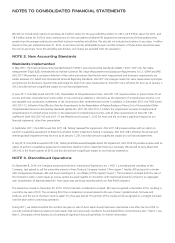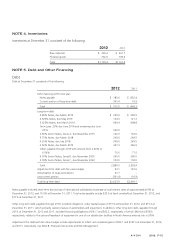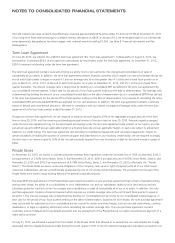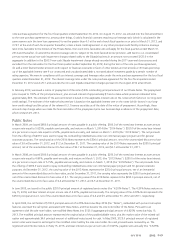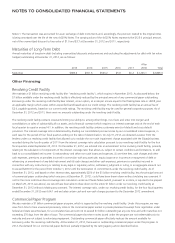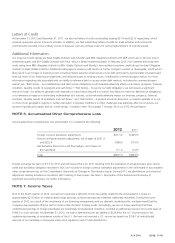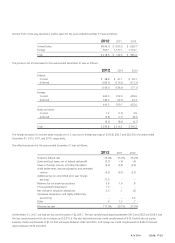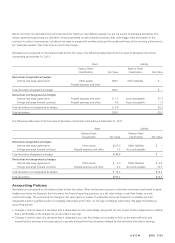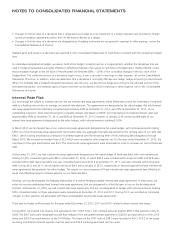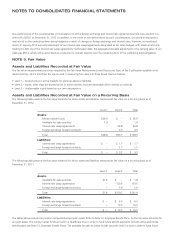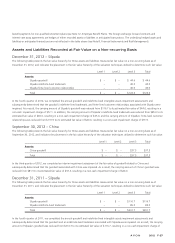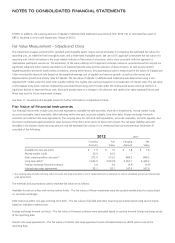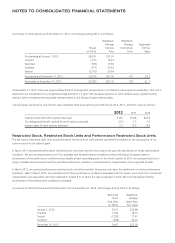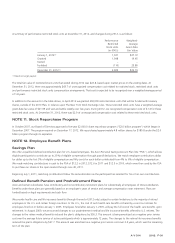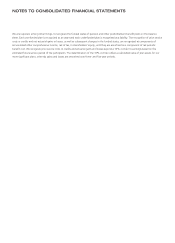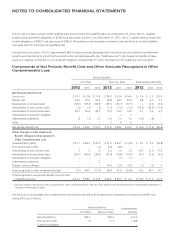Avon 2012 Annual Report Download - page 89
Download and view the complete annual report
Please find page 89 of the 2012 Avon annual report below. You can navigate through the pages in the report by either clicking on the pages listed below, or by using the keyword search tool below to find specific information within the annual report.NOTES TO CONSOLIDATED FINANCIAL STATEMENTS
• Changes in the fair value of a derivative that is designated as a hedge of a net investment in a foreign operation are recorded in foreign
currency translation adjustments within AOCI to the extent effective as a hedge.
• Changes in the fair value of a derivative not designated as a hedging instrument are recognized in earnings in other expense, net on the
Consolidated Statements of Income.
Realized gains and losses on a derivative are reported on the Consolidated Statements of Cash Flows consistent with the underlying hedged
item.
For derivatives designated as hedges, we assess, both at the hedge’s inception and on an ongoing basis, whether the derivatives that are
used in hedging transactions are highly effective in offsetting changes in fair values or cash flows of hedged items. Highly effective means
that cumulative changes in the fair value of the derivative are between 85% – 125% of the cumulative changes in the fair value of the
hedged item. The ineffective portion of a derivative’s gain or loss, if any, is recorded in earnings in other expense, net on the Consolidated
Statements of Income. In addition, when we determine that a derivative is not highly effective as a hedge, hedge accounting is discontinued.
When it is probable that a hedged forecasted transaction will not occur, we discontinue hedge accounting for the affected portion of the
forecasted transaction, and reclassify gains or losses that were accumulated in AOCI to earnings in other expense, net on the Consolidated
Statements of Income.
Interest Rate Risk
Our borrowings are subject to interest rate risk. We use interest-rate swap agreements, which effectively convert the fixed rate on long-term
debt to a floating interest rate, to manage our interest rate exposure. The agreements are designated as fair value hedges. We held interest-
rate swap agreements that effectively converted approximately 62% at December 31, 2012, and 74% at December 31, 2011, of our
outstanding long-term, fixed-rate borrowings to a variable interest rate based on LIBOR. Our total exposure to floating interest rates was
approximately 69% at December 31, 2012, and 82% at December 31, 2011; however, in January 2013, we terminated eight of our
interest-rate swap agreements designated as fair value hedges, with notional amounts totaling $1,000.
In March 2012, we terminated two of our interest-rate swap agreements designated as fair value hedges, with notional amounts totaling
$350. As of the interest-rate swap agreements’ termination date, the aggregate favorable adjustment to the carrying value of our debt was
$46.1, which is being amortized as a reduction to interest expense over the remaining term of the underlying debt obligations through
March 2019. We incurred termination fees of $2.5 which were recorded in other expense, net. For the year ended December 31, 2012, the
net impact of the gain amortization was $4.4. The interest-rate swap agreements were terminated in order to increase our ratio of fixed-rate
debt.
At December 31, 2012, we had interest-rate swap agreements designated as fair value hedges of fixed-rate debt, with notional amounts
totaling $1,375. Unrealized gains were $93.1 at December 31, 2012, of which $90.3 were included within long-term debt and $2.8 were
included within debt maturing within one year. Unrealized gains were $147.6 at December 31, 2011, and were included within long-term
debt. During 2012 and 2011, we recorded a net loss of $8.4 and a net gain of $53.2, respectively, in interest expense for these interest-rate
swap agreements designated as fair value hedges. The impact on interest expense of these interest-rate swap agreements was offset by an
equal and offsetting impact in interest expense on our fixed-rate debt.
At times, we may de-designate the hedging relationship of a receive-fixed/pay-variable interest-rate swap agreement. In these cases, we
enter into receive-variable/pay-fixed interest-rate swap agreements that are designated to offset the gain or loss on the de-designated
contract. At December 31, 2012, we had interest-rate swap agreements that are not designated as hedges with notional amounts totaling
$250. Unrealized losses on these agreements were immaterial at December 31, 2012 and 2011. During 2012, we recorded an immaterial
net gain in other expense, net associated with these undesignated interest-rate swap agreements.
There was no hedge ineffectiveness for the years ended December 31, 2012, 2011 and 2010, related to these interest-rate swaps.
During 2007, we entered into treasury lock agreements (the “2007 locks”) with notional amounts totaling $500.0 that expired on July 31,
2008. The 2007 locks were designated as cash flow hedges of the anticipated interest payments on $250.0 principal amount of the 2013
Notes and $250.0 principal amount of the 2018 Notes. The losses on the 2007 locks of $38.0 were recorded in AOCI. $19.2 of the losses
are being amortized to interest expense over five years and $18.8 are being amortized over ten years.


